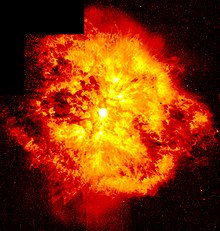Wolf–Rayet star
Wolf–Rayet stars (WR stars) are massive stars (over 20 solar masses initially). They are losing mass rapidly by means of a very strong stellar wind, with speeds up to 2000 km/s. While our own Sun loses about 10−14 solar masses every year, Wolf–Rayet stars typically lose 10−5 solar masses a year.[1] (The last number is one million times larger than the second-to-last number.)

Wolf–Rayet stars are extremely hot, with surface temperatures in the range of 30,000 K to around 200,000 K that make them look blue in color.[2] They are also highly luminous, from tens of thousands to several million times the bolometric luminosity of the Sun, although not exceptionally bright visually since most of their output is in far[clarification needed] ultraviolet and even "soft" X-rays.[3]
Clarification of terms
changeIn astronomy, luminosity is not quite the same thing as brightness. Luminosity measures the total amount of energy emitted by a star or other astronomical object in SI units of joules per second, which are watts. A watt is one unit of power, and just as a light bulb is measured in watts, so is the Sun, which has a total power output of 3.846×1026 W. This number is the basic metric used in astronomy: it is known as 1 solar luminosity, the symbol for which is .
Radiant power, however, is not the only way to conceptualize brightness, so other metrics are also used. The most common is apparent magnitude, which is the perceived brightness of an object from an observer on Earth at visible wavelengths. Other metrics are absolute magnitude, which is an object's intrinsic brightness at visible wavelengths, irrespective of distance. The measure of luminosity is "bolometric magnitude", the total power output across all wavelengths.
References
change